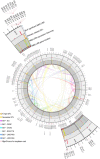Genome-wide mapping of NBS-LRR genes and their association with disease resistance in soybean
- PMID: 22877146
- PMCID: PMC3493331
- DOI: 10.1186/1471-2229-12-139
Genome-wide mapping of NBS-LRR genes and their association with disease resistance in soybean
Abstract
Background: R genes are a key component of genetic interactions between plants and biotrophic bacteria and are known to regulate resistance against bacterial invasion. The most common R proteins contain a nucleotide-binding site and a leucine-rich repeat (NBS-LRR) domain. Some NBS-LRR genes in the soybean genome have also been reported to function in disease resistance. In this study, the number of NBS-LRR genes was found to correlate with the number of disease resistance quantitative trait loci (QTL) that flank these genes in each chromosome. NBS-LRR genes co-localized with disease resistance QTL. The study also addressed the functional redundancy of disease resistance on recently duplicated regions that harbor NBS-LRR genes and NBS-LRR gene expression in the bacterial leaf pustule (BLP)-induced soybean transcriptome.
Results: A total of 319 genes were determined to be putative NBS-LRR genes in the soybean genome. The number of NBS-LRR genes on each chromosome was highly correlated with the number of disease resistance QTL in the 2-Mb flanking regions of NBS-LRR genes. In addition, the recently duplicated regions contained duplicated NBS-LRR genes and duplicated disease resistance QTL, and possessed either an uneven or even number of NBS-LRR genes on each side. The significant difference in NBS-LRR gene expression between a resistant near-isogenic line (NIL) and a susceptible NIL after inoculation of Xanthomonas axonopodis pv. glycines supports the conjecture that NBS-LRR genes have disease resistance functions in the soybean genome.
Conclusions: The number of NBS-LRR genes and disease resistance QTL in the 2-Mb flanking regions of each chromosome was significantly correlated, and several recently duplicated regions that contain NBS-LRR genes harbored disease resistance QTL for both sides. In addition, NBS-LRR gene expression was significantly different between the BLP-resistant NIL and the BLP-susceptible NIL in response to bacterial infection. From these observations, NBS-LRR genes are suggested to contribute to disease resistance in soybean. Moreover, we propose models for how NBS-LRR genes were duplicated, and apply Ks values for each NBS-LRR gene cluster.
Figures


Similar articles
-
Fine mapping of a resistance gene to bacterial leaf pustule in soybean.Theor Appl Genet. 2010 May;120(7):1443-50. doi: 10.1007/s00122-010-1266-0. Epub 2010 Jan 20. Theor Appl Genet. 2010. PMID: 20087567
-
RNA-Seq analysis of a soybean near-isogenic line carrying bacterial leaf pustule-resistant and -susceptible alleles.DNA Res. 2011 Dec;18(6):483-97. doi: 10.1093/dnares/dsr033. Epub 2011 Oct 10. DNA Res. 2011. PMID: 21987089 Free PMC article.
-
Identification of Novel Genomic Regions for Bacterial Leaf Pustule (BLP) Resistance in Soybean (Glycine max L.) via Integrating Linkage Mapping and Association Analysis.Int J Mol Sci. 2022 Feb 14;23(4):2113. doi: 10.3390/ijms23042113. Int J Mol Sci. 2022. PMID: 35216225 Free PMC article.
-
Characterization of Disease Resistance Loci in the USDA Soybean Germplasm Collection Using Genome-Wide Association Studies.Phytopathology. 2016 Oct;106(10):1139-1151. doi: 10.1094/PHYTO-01-16-0042-FI. Epub 2016 Jul 11. Phytopathology. 2016. PMID: 27135674 Review.
-
The role of microRNAs in NBS-LRR gene expression and its implications for plant immunity and crop development.Transgenic Res. 2024 Aug;33(4):159-174. doi: 10.1007/s11248-024-00387-9. Epub 2024 Jun 10. Transgenic Res. 2024. PMID: 38856866 Review.
Cited by
-
Genome-wide SNP identification and characterization in two soybean cultivars with contrasting Mungbean Yellow Mosaic India Virus disease resistance traits.PLoS One. 2015 Apr 13;10(4):e0123897. doi: 10.1371/journal.pone.0123897. eCollection 2015. PLoS One. 2015. PMID: 25875830 Free PMC article.
-
Progress in soybean functional genomics over the past decade.Plant Biotechnol J. 2022 Feb;20(2):256-282. doi: 10.1111/pbi.13682. Epub 2021 Aug 25. Plant Biotechnol J. 2022. PMID: 34388296 Free PMC article. Review.
-
Genome-wide identification and expression analysis of NBS-encoding genes in Malus x domestica and expansion of NBS genes family in Rosaceae.PLoS One. 2014 Sep 18;9(9):e107987. doi: 10.1371/journal.pone.0107987. eCollection 2014. PLoS One. 2014. PMID: 25232838 Free PMC article.
-
CNL Disease Resistance Genes in Soybean and Their Evolutionary Divergence.Evol Bioinform Online. 2015 Apr 7;11:49-63. doi: 10.4137/EBO.S21782. eCollection 2015. Evol Bioinform Online. 2015. PMID: 25922568 Free PMC article.
-
Evolutionary balance between LRR domain loss and young NBS-LRR genes production governs disease resistance in Arachis hypogaea cv. Tifrunner.BMC Genomics. 2019 Nov 13;20(1):844. doi: 10.1186/s12864-019-6212-1. BMC Genomics. 2019. PMID: 31722670 Free PMC article.
References
-
- Flor HH. Host-Parasite Interaction in Flax Rust - Its Genetics and Other Implications. Phytopathology. 1955;45(12):680–685.
-
- Ashfield T, Bocian A, Held D, Henk AD, Marek LF, Danesh D, Penuela S, Meksem K, Lightfoot DA, Young ND. et al.Genetic and physical localization of the soybean Rpg1-b disease resistance gene reveals a complex locus containing several tightly linked families of NBS-LRR genes. Mol Plant Microbe In. 2003;16(9):817–826. doi: 10.1094/MPMI.2003.16.9.817. - DOI - PubMed
Publication types
MeSH terms
Substances
LinkOut - more resources
Full Text Sources
Other Literature Sources
Research Materials
Miscellaneous

